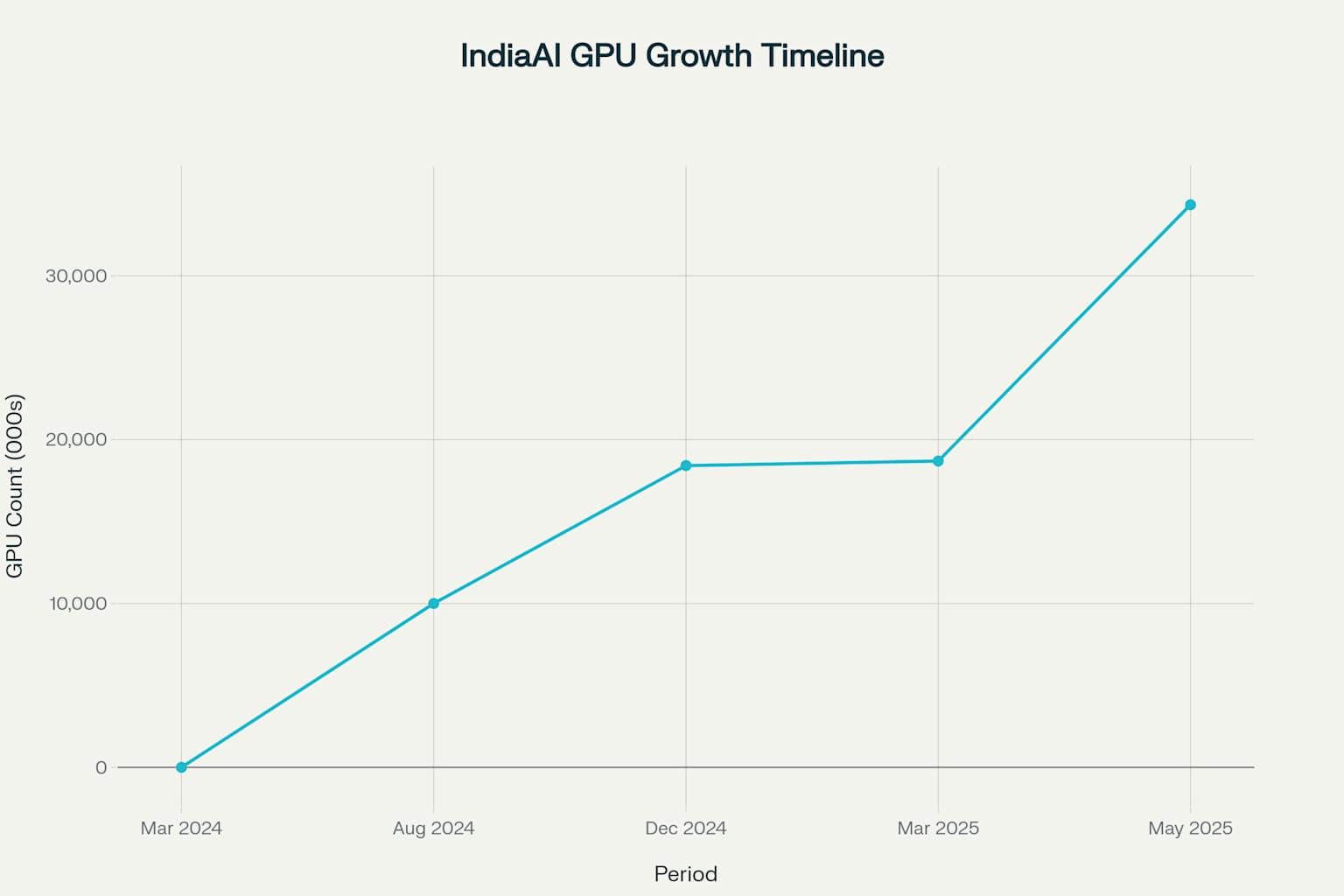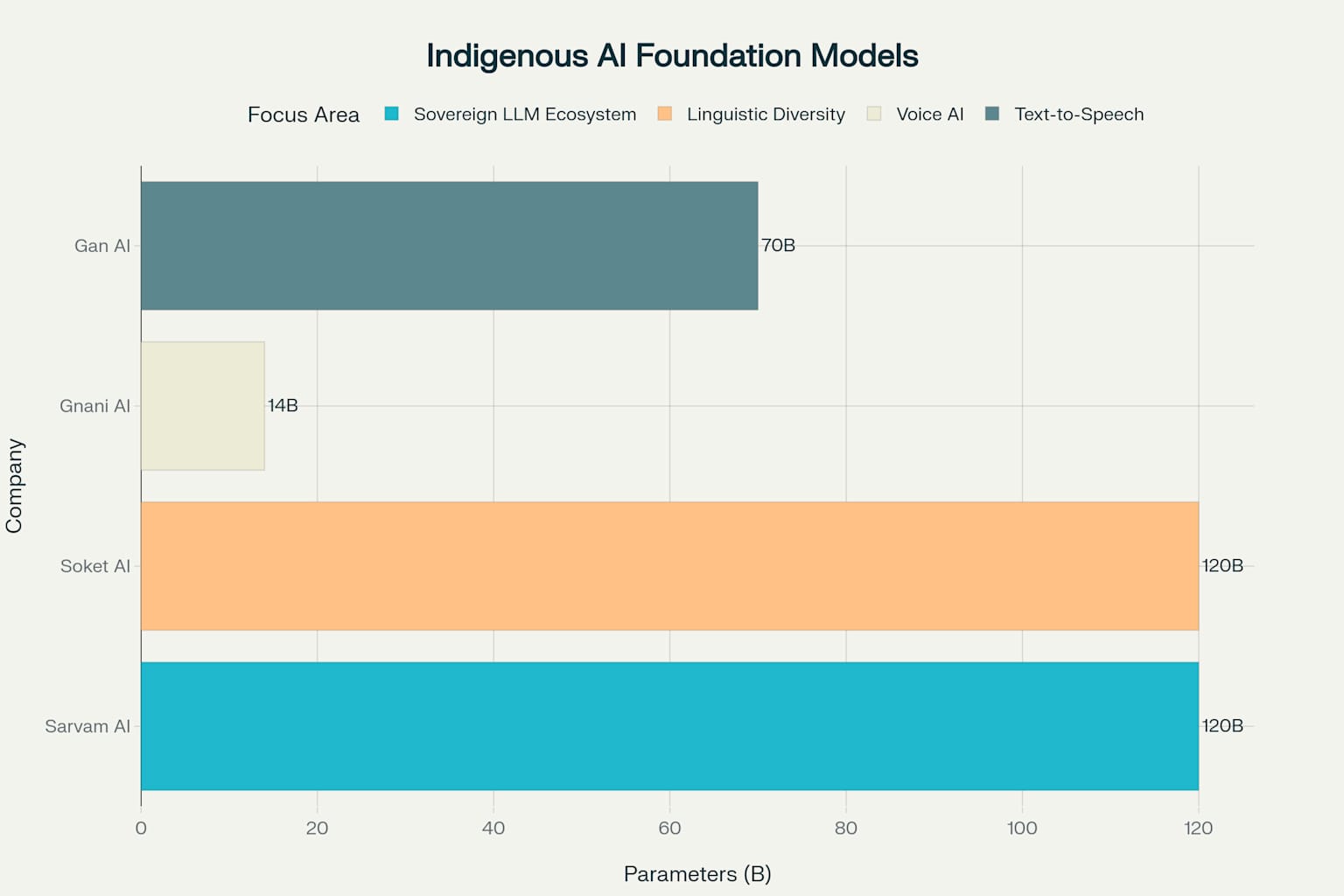India has achieved a major milestone in its artificial intelligence journey with the IndiaAI Mission scaling up its compute infrastructure to over 34,000 Graphics Processing Units (GPUs) while simultaneously backing the development of four indigenous foundation models that promise to reshape the country’s AI landscape. The recent announcement by Union IT Minister Ashwini Vaishnaw in May 2025 marks a significant acceleration in India’s quest to become a global AI leader, democratizing access to cutting-edge technology while ensuring strategic autonomy in critical AI capabilities.
Strategic Infrastructure Expansion: From 10,000 to 34,000+ GPUs
Second Round Empanelment Drives Massive Scale-Up
The IndiaAI Mission’s compute capacity has experienced remarkable growth, with the addition of approximately 16,000 new GPUs in the second round of empanelment, bringing the total to 34,333 GPUs. This expansion represents a 240% increase from the initial target of 10,000 GPUs set when the mission was launched in March 2024. The dramatic scaling demonstrates India’s commitment to building robust AI infrastructure that can support both research initiatives and commercial applications across diverse sectors.

Seven Cloud Service Providers (CSPs) have been onboarded in the second round, joining existing partners such as Jio Platforms, NxtGen Data Centre, CtrlS Datacenters, Tata Communications, and E2E Networks. The newly empaneled companies include Cyfuture India, Ishan Infotech, Netmagic, Sify, Vensysco, Locuz, and Yotta, who collectively offer a diverse mix of high-performance computing hardware including Nvidia GPUs (H100, H200, B200), AMD chips (MI300X, MI325X), and Intel’s Gaudi series.
Cost-Effective Computing Infrastructure
The IndiaAI Compute Portal provides unprecedented access to AI infrastructure at highly subsidized rates, with GPU computing available for as low as Rs 67-100 per hour for eligible users. This pricing represents a significant advantage compared to global market rates of $2.5-$3 (approximately ₹259) per GPU hour, making advanced AI development accessible to startups, researchers, and academic institutions. The government’s 40% subsidy under the Common Compute Facility initiative ensures that financial barriers do not impede innovation and research.

Technical Specifications and Capabilities
Through the IndiaAI Compute Portal, users now have access to a vast pool of AI chips comprising over 15,000 Nvidia H100 units, along with B200s, H200s, AMD GPUs, AWS Inferentia 2 units, Intel Gaudi chips, and other advanced computing resources. This distributed AI infrastructure spans multiple locations across India, ensuring redundancy, scalability, and reduced latency for users nationwide. The infrastructure’s capacity of 34,000+ GPUs positions India among the top nations globally in terms of AI compute availability, providing the computational backbone necessary for training large-scale AI models.
Indigenous Foundation Models: Building India’s AI Sovereignty
Four Strategic Selections for National AI Development
The IndiaAI Mission has strategically selected four startups to develop indigenous foundation models that address India’s unique linguistic, cultural, and sectoral needs. Following the initial selection of Sarvam AI in April 2025, three additional companies—Soket AI, Gnani AI, and Gan AI—have been chosen from over 506 proposals received since the Call for Proposals launched in January 2025.

Sarvam AI: Pioneering Sovereign LLM Ecosystem
Sarvam AI, the first startup selected under the IndiaAI Mission, is developing a comprehensive Sovereign LLM Ecosystem with a 120-billion parameter open-source model designed to enhance governance and public service delivery. The company has already demonstrated significant progress with the release of Sarvam-M, a 24-billion parameter multilingual model that supports ten Indian languages and incorporates hybrid reasoning capabilities for both general conversation and complex logical reasoning. Sarvam AI has received access to 4,096 Nvidia H100 GPUs for six months to train their foundational model, with applications including “2047: Citizen Connect” and “AI4Pragati” for government services.
Soket AI: Optimizing for Linguistic Diversity
Soket AI is tasked with developing an open-source 120-billion parameter foundation model specifically optimized for India’s remarkable linguistic diversity. The model will target critical sectors including defense, healthcare, and education, ensuring that India’s 22 scheduled languages and numerous dialects are adequately represented in AI systems. This focus on linguistic inclusivity addresses a critical gap in global AI models, which often exhibit biases toward English and Western languages.
Gnani AI: Advancing Voice AI Capabilities
Gnani AI, backed by Info Edge Ventures, is developing a 14-billion parameter Voice AI foundation model that delivers multilingual, real-time speech processing with advanced reasoning capabilities. The model aims to support India’s vast linguistic diversity through voice-to-voice large language models, enabling more inclusive and accessible AI interactions for users across different language communities. Ganesh Gopalan, Co-Founder and CEO of Gnani AI, emphasized that “transformative AI must speak the language of the people it serves”.
Gan AI: Superhuman Text-to-Speech Innovation
Gan AI is developing a 70-billion parameter multilingual foundation model with a specific focus on achieving next-generation text-to-speech capabilities that aim to surpass current global standards. The model represents India’s ambition to lead in specific AI domains, with Minister Vaishnaw setting the ambitious goal that “whichever sector they focus on, they must be among the top five in the world”.

Strategic Implementation and Policy Framework
Comprehensive Mission Architecture
The IndiaAI Mission operates through seven foundational pillars designed to create a holistic AI ecosystem. The largest allocation of ₹4,563.36 crores (44% of the total budget) is dedicated to compute capacity, reflecting the critical importance of infrastructure in AI development. Other key pillars include the IndiaAI Innovation Centre (₹1,971.37 crores), startup financing (₹1,942.5 crores), and future skills development (₹882.94 crores).

Data Infrastructure and Ethical AI Development
The mission emphasizes the development of ethically sourced, consent-based datasets through initiatives like AIKosha, which currently hosts over 367 datasets and 80+ models. This approach reduces reliance on synthetic and foreign data while ensuring that Indian cultural values and linguistic diversity are preserved in AI development. The Digital India Bhashini initiative, operating in parallel, provides AI-driven language technology solutions for all 22 scheduled Indian languages, supporting over 350 AI-based language models.
Public-Private Partnership Model
The IndiaAI Mission leverages extensive public-private partnerships to maximize resource utilization and innovation potential. The empanelment process ensures transparent selection of service providers while maintaining competitive pricing and high-quality service delivery. This collaborative approach enables rapid scaling while distributing costs and risks across multiple stakeholders.
Global Competitive Context and Strategic Positioning
Responding to International AI Competition
The IndiaAI Mission’s acceleration comes amid intensifying global competition in artificial intelligence, particularly following developments like China’s DeepSeek model, which demonstrated that foundational AI capabilities could be developed cost-effectively. Minister Vaishnaw has emphasized that India’s approach focuses on creating AI solutions at a fraction of the cost incurred by other countries, similar to India’s successful and cost-effective lunar mission.
Building Strategic Autonomy
The development of indigenous foundation models serves multiple strategic objectives beyond technological advancement. Cultural sensitivity and educational sovereignty ensure that AI systems reflect Indian values and linguistic diversity rather than foreign ideologies. Data sovereignty protects sensitive national information from potential surveillance or exploitation by foreign entities. Strategic autonomy in AI governance allows India to participate as an equal player in shaping global AI frameworks rather than remaining dependent on foreign technologies.
Talent Development and Reverse Brain Drain
The IndiaAI Mission is designed to foster reverse brain drain by creating attractive opportunities for Indian AI talent to contribute to domestic innovation. The initiative includes large-scale programs in collaboration with academia and industry to train people in data annotation, AI application development, and core AI research. AI-focused skilling initiatives are being rolled out across 240 universities nationwide, ensuring a robust talent pipeline for sustained AI development.
Implementation Challenges and Future Outlook
Technical and Infrastructure Challenges
Despite the impressive scale-up, the IndiaAI Mission faces several implementation challenges. The global shortage of high-end GPUs, dominated by companies like Nvidia, creates supply chain dependencies that must be carefully managed. Additionally, the need for substantial power infrastructure and cooling systems for data centers presents ongoing operational challenges that require sustained investment and planning.
Cost Management and Sustainability
While the current subsidized pricing model democratizes access to AI compute resources, long-term sustainability requires careful balance between accessibility and cost recovery. The mission’s success depends on efficient utilization of the 34,000+ GPUs and the ability to generate sufficient demand from the research and startup community to justify the substantial infrastructure investment.
Regulatory and Ethical Framework Development
India is developing a unique “techno-legal” approach to AI regulation that combines legal provisions with technological tools for detecting deepfakes, biases, and ensuring safe AI usage. This innovative regulatory framework aims to provide more effective oversight than purely legal approaches while maintaining innovation-friendly policies. The Safe & Trusted AI pillar, though receiving the smallest budget allocation of ₹20.46 crores, plays a crucial role in ensuring responsible AI development.
Economic Impact and Future Projections
Market Transformation Potential
The IndiaAI Mission’s infrastructure and foundational models are positioned to catalyze significant economic transformation across multiple sectors. Applications in healthcare, agriculture, education, governance, and financial services are expected to generate substantial productivity gains and new business opportunities. The democratization of AI access through affordable compute resources enables smaller companies and startups to participate in AI innovation, potentially creating a more diverse and competitive AI ecosystem.
Global Leadership Aspirations
Minister Vaishnaw has articulated India’s ambition to be among the top five nations globally in AI capability, usage, and talent. This goal is supported by India’s existing strengths, including its ranking as the top country in AI skill penetration and recognition among the top 10 AI nations in Stanford University’s Global AI Vibrancy ranking. The combination of cost-effective infrastructure, indigenous model development, and comprehensive talent development programs positions India to achieve significant influence in global AI governance and standards.
Conclusion
The IndiaAI Mission’s expansion to 34,000+ GPUs and the selection of four indigenous foundation model developers represents a transformative moment in India’s technological evolution. By combining massive infrastructure scaling with strategic investments in sovereignty-focused AI development, India is positioning itself as a major player in the global AI landscape while ensuring that technological advancement serves national interests and cultural values.
The success of this initiative will be measured not only by technical achievements but also by its ability to democratize AI access, foster innovation across diverse sectors, and maintain India’s strategic autonomy in an increasingly AI-driven global economy. As these foundational models progress toward deployment and the compute infrastructure reaches full utilization, India’s vision of becoming a global AI leader while serving its billion-plus citizens may well become reality.
The convergence of substantial infrastructure investment, indigenous innovation, and comprehensive ecosystem development under the IndiaAI Mission demonstrates India’s commitment to leveraging artificial intelligence as a tool for national development and global leadership. With continued execution of this ambitious roadmap, India is poised to emerge as a defining force in the future of artificial intelligence technology and governance.


















